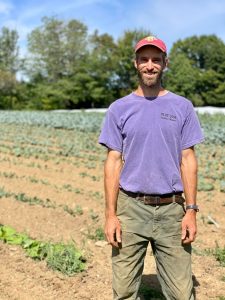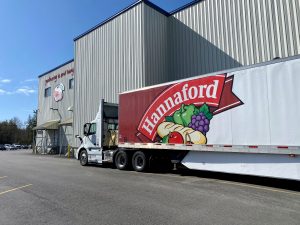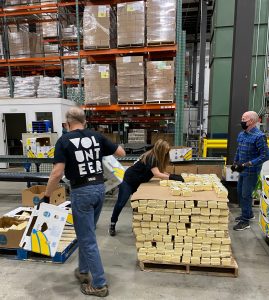How does Good Shepherd Food Bank of Maine find food?
In our last blog post, you learned the difference between a food bank and a food pantry and now you might be interested in learning more about how we source and receive food for our network of over 500 partner agencies.
Good Shepherd Food Bank has distributed 31.1 million meals to our neighbors since the beginning of the COVID pandemic. As we continue to face the needs and challenges of the pandemic, we have set a bold goal to raise $250 million in an unprecedented statewide campaign, Campaign to End Hunger, with a total of $150 million in large-scale food donations from food retailers, manufacturers, producers, and Maine farm partners.
How do we get food?

From Our Farm Partners
Good Shepherd Food Bank’s Mainers Feeding Mainers program was launched by forming partnerships with the people who work Maine’s land and the sea, to provide food for Mainers facing hunger. Our goal: to get fresh and nutritionally balanced Maine-harvested food to Maine families in need. We have worked with more than 80 farm partners to acquire and distribute over two million pounds of fresh, Maine-grown food per year to families in need.
We welcome local food producers throughout Maine to join our work to eliminate hunger in the state. Become a Mainers Feeding Mainers partner.
From Companies and Local Retail Businesses
Small, medium and large food businesses, restaurants, and bakeries donate food to the Food Bank. These donations can be big – a truckload of milk – or smaller – a few boxes of extra bread from a local bakery. Donations from these groups include everything from dairy products to canned goods or even meat products.

Our big breakthrough with the food industry came in 1983 when Hannaford Supermarkets studied the process of retail companies contributing products to major food banks and made the decision to contribute its products to Good Shepherd Food Bank, for distribution to nonprofit hunger-relief agencies that feed low-income people. Hannaford established a reclamation center to facilitate the process of contributing products from the entire service area of Hannaford Supermarkets.
The addition of Walmart Superstores, Shaw’s Supermarkets (Albertsons), Barber Foods Co., Lepage Bakeries, SureWinner Foods, and many smaller companies as food donors have ensured a steady supply of highly nutritious foods for Maine’s people who are in greatest need of assistance.
Purchased Food
We purchase healthy food to supplement what we receive in donations. Purchased products are nutritious, shelf-stable, pantry staple items such as peanut butter, canned vegetables and beans, fresh and frozen meat, pasta, and rice.
From Federal Programs
The United States Department of Agriculture (USDA) provides billions of meals to our neighbors facing hunger each year. The USDA purchases food from farmers and provides the food to food banks for distribution in their partner agencies and the communities they serve. The USDA’s programs are one of the most reliable sources of food for food banks, providing 1.7 billion meals in 2020.
Unfortunately, food banks could lose 50% of the food – or 850 million meals – from the USDA in early 2021. At a time when so many people are facing hunger, any decrease in food support to food banks will be devastating.
Want to get involved? Tell your members of Congress that food banks need an increase in USDA food to help our neighbors facing hunger.
The Emergency Food Assistance Program (TEFAP) – Provides USDA commodities to families in need of short-term hunger relief through emergency food providers like food banks.
The Commodity Supplemental Food Program (CSFP) – Provides food assistance for low-income seniors with a monthly package of healthy USDA commodities.
How can you help?
Host a Virtual Food Drive
Virtual Food Drives are an easy way to encourage your network to help you end hunger by raising funds online. Each drive can be customized, whether it’s a personal fundraiser, school project, large corporation, or a small group, you set your financial goal, add a description of your fundraiser and upload a logo or picture if you choose. Your efforts will directly impact Mainers experiencing food insecurity.

Start your virtual food drive here.
Volunteer at a local pantry or with Good Shepherd Food Bank
Volunteering at Good Shepherd Food Bank or at your local food pantry is one of the best ways to give back to your neighbors struggling with food insecurity, especially during the current pandemic. By donating a few hours of your time, you’ll provide meals to families, children, seniors and those in need across Maine. Get involved today!
Donate
Financial gifts are the most efficient way to help provide healthy food to Maine neighbors. Give today.
For more information, visit www.feedingmaine.org.